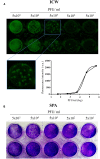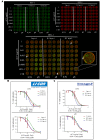A Novel Method to Titrate Herpes Simplex Virus-1 (HSV-1) Using Laser-Based Scanning of Near-Infrared Fluorophores Conjugated Antibodies
- PMID: 28659899
- PMCID: PMC5469900
- DOI: 10.3389/fmicb.2017.01085
A Novel Method to Titrate Herpes Simplex Virus-1 (HSV-1) Using Laser-Based Scanning of Near-Infrared Fluorophores Conjugated Antibodies
Abstract
Among several strategies used for Herpes simplex virus (HSV) detection in biological specimens, standard plaque assay (SPA) remains the most reliable method to evaluate virus infectivity and quantify viral replication. However, it is a manual procedure, thereby affected by operator subjectivity, and it may be particularly laborious for multiple sample analysis. Here we describe an innovative method to perform the titration of HSV type 1 (HSV-1) in different samples, using the "In-Cell WesternTM" Assay (ICW) from LI-COR, a quantitative immunofluorescence assay that exploits laser-based scanning of near infrared (NIR). In particular, we employed NIR-immunodetection of viral proteins to monitor foci of HSV-1 infection in cell monolayers, and exploited an automated detection of their fluorescence intensity to evaluate virus titre. This innovative method produced similar and superimposable values compared to SPA, but it is faster and can be performed in 96 well plate, thus allowing to easily and quickly analyze and quantify many samples in parallel. These features make our method particularly suitable for the screening and characterization of antiviral compounds, as we demonstrated by testing acyclovir (ACV), the main anti-HSV-1 drug. Moreover, we developed a new data analysis system that allowed to overcome potential bias due to unspecific florescence signals, thus improving data reproducibility. Overall, our method may represents a useful tool for both clinical and research purposes.
Keywords: HSV-1; antivirals; herpes simplex virus; immunostaining; near-infrared fluorescence; plaque assay; virus titration.
Figures



Similar articles
-
Experimental Dissection of the Lytic Replication Cycles of Herpes Simplex Viruses in vitro.Front Microbiol. 2018 Oct 11;9:2406. doi: 10.3389/fmicb.2018.02406. eCollection 2018. Front Microbiol. 2018. PMID: 30386309 Free PMC article. Review.
-
A direct quantitative PCR-based measurement of herpes simplex virus susceptibility to antiviral drugs and neutralizing antibodies.J Virol Methods. 2017 Apr;242:46-52. doi: 10.1016/j.jviromet.2017.01.007. Epub 2017 Jan 16. J Virol Methods. 2017. PMID: 28093274
-
Virucidal effect of peppermint oil on the enveloped viruses herpes simplex virus type 1 and type 2 in vitro.Phytomedicine. 2003;10(6-7):504-10. doi: 10.1078/094471103322331467. Phytomedicine. 2003. PMID: 13678235
-
Expression of herpes simplex virus type 1 recombinant thymidine kinase and its application to a rapid antiviral sensitivity assay.Antiviral Res. 2011 Aug;91(2):142-9. doi: 10.1016/j.antiviral.2011.05.015. Epub 2011 Jun 2. Antiviral Res. 2011. PMID: 21669227
-
Antiviral agents for herpes simplex virus.Adv Pharmacol. 2013;67:1-38. doi: 10.1016/B978-0-12-405880-4.00001-9. Adv Pharmacol. 2013. PMID: 23885997 Review.
Cited by
-
Growth, Purification, and Titration of Oncolytic Herpes Simplex Virus.J Vis Exp. 2021 May 13;(171):10.3791/62677. doi: 10.3791/62677. J Vis Exp. 2021. PMID: 34057449 Free PMC article.
-
A simple, fast and reliable scan-based technique as a novel approach to quantify intracellular bacteria.BMC Microbiol. 2019 Nov 12;19(1):252. doi: 10.1186/s12866-019-1625-1. BMC Microbiol. 2019. PMID: 31718545 Free PMC article.
-
Experimental Dissection of the Lytic Replication Cycles of Herpes Simplex Viruses in vitro.Front Microbiol. 2018 Oct 11;9:2406. doi: 10.3389/fmicb.2018.02406. eCollection 2018. Front Microbiol. 2018. PMID: 30386309 Free PMC article. Review.
-
High-Throughput Characterization of Viral and Cellular Protein Expression Patterns During JC Polyomavirus Infection.Front Microbiol. 2019 Apr 17;10:783. doi: 10.3389/fmicb.2019.00783. eCollection 2019. Front Microbiol. 2019. PMID: 31065251 Free PMC article.
-
Experimental Data Based Machine Learning Classification Models with Predictive Ability to Select in Vitro Active Antiviral and Non-Toxic Essential Oils.Molecules. 2020 May 25;25(10):2452. doi: 10.3390/molecules25102452. Molecules. 2020. PMID: 32466318 Free PMC article.
References
-
- Civitelli L., Panella S., Marcocci M. E., De Petris A., Garzoli S., Pepi F., et al. (2014). In vitro inhibition of herpes simplex virus type 1 replication by Mentha suaveolens essential oil and its main component piperitenone oxide. Phytomedicine 21 857–865. 10.1016/j.phymed.2014.01.013 - DOI - PubMed
LinkOut - more resources
Full Text Sources
Other Literature Sources
Miscellaneous

